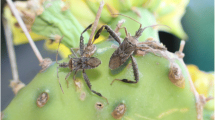Summary
Adults of the staphylinid beetle Leistotrophus versicolor Grav. aggregate at vertebrate dung and carrion where males and females forage for adult Diptera. Some males aggressively exclude others from dung and carrion. Winners in male combat gain access to many females, which are often receptive at these foraging sites. The mating system can be categorized as resource defense polygyny. Males vary greatly in size, are larger than females on average, and have allometrically enlarged mandibles that they use in fighting. Large males consistently defeat smaller ones. Some males employ female mimicry in order to avoid aggression, remaining at dung where they forage and even obtain copulations while being courted by rival males. Female mimicry is most often practiced by males that are smaller than their rivals or by males that are unable to use their jaws aggressively because they are feeding or courting females when encountered by an opponent. Female mimicry is a conditional tactic of mature males; some individuals behave like females toward larger males but attack smaller rivals.
Similar content being viewed by others
References
Alcock J, Forsyth A (1988) Post-copulatory aggression toward their mates by males of the rove beetle Leistotrophus versicolor (Coleoptera: Staphylinidae). Behav Ecol Sociobiol 22:303–308
Arnold SJ (1976) Sexual behavior, sexual interference and sexual defense in the salamanders Ambystoma maculatum, Ambystoma tigrinum and Plethodon jordani. Z Tierpsychol 42:247–300
Bradbury JW, Vehrencamp SL (1977) Social organization and foraging in emballonurid bats. III. Mating systems. Behav Ecol Sociobiol 2:1–17
Cade WH (1980) Alternative male reproductive strategies. Fla Entomol 63:30–45
Cade WH (1984) Genetic variation underlying sexual behavior and reproduction. Am Zool 24:355–366
Caro TM, Bateson P (1986) Organization and ontogeny of alternative tactics. Anim Behav 34:1483–1499
Crespi BJ (1986) Size assessment and alternative fighting tactics in Elaphrothrips tuberculatus (Insecta: Thysanoptera). Anim Behav 34:1324–1335
Darwin C (1871) The descent of man and selection in relation to sex. Murray, London
Dawkins R (1980) Good strategy or evolutionarily stable strategy? In: Barlow GW, Silverberg J (eds) Sociobiology: beyond nature/nurture? Westview Press, Boulder, CO
Dominey WJ (1980) Female mimicry in male bluegill sunfish —A genetic polymorphism? Nature 284:546–548
Dominey WJ (1984) Alternative mating tactics and evolutionarily stable strategies. Am Zool 24:385–396
Eberhard WG (1982) Beetle horn dimorphism: making the best of a bad lot. Am Nat 119:420–426
Emlen ST, Oring LW (1977) Ecology, sexual selection and the evolution of mating systems. Science 197:215–223
Forsyth A, Montgomerie RD (1987) Alternative reproductive tactics in the territorial damselfly Calopteryx maculata: sneaking by older males. Behav Ecol Sociobiol 21:73–82
Forsyth A, Peck SJ (1982) Competition, structure and competitive behaviour in a guild of Ecuadorian rainforest dung beetles (Coleoptera: Scarabeidae). Can J Zool 60:1624–1634
Gadgil M (1972) Male dimorphism as a consequence of sexual selection. Am Nat 106:574–580
Gross MR (1982) Sneakers, satellites, and parentals: polymorphic mating strategies in North American sunfishes. Z Tierpsychol 60:1–26
Gross MR, Charnov EL (1980) Alternative life histories in bluegill sunfish. Proc Nat Acad Sci 77:6937–6940
Heinrich B, Bartholomew GA (1979) Ecology of the African dung beetle. Sci Am 241(5):146–156
Janzen D (1983) Seasonal change in abundance of large nocturnal dung beetles (Scarabeidae) in a Costa Rican deciduous forest and adjacent horse pasture. Oikos 41:274–283
O'Neill KM (1985) Egg size, prey size, and sexual size dimorphism in digger wasps. Can J Zool 63:2187–2193
Peschke K (1978) The female sex pheromone of the staphylinid beetle, Aleochara curtula. J Insect Physiol 24:197–200
Peschke K (1985) Immature males of Aleochara curtula avoid intrasexual aggressions by producing the female sex pheromone. Naturwissenschaften 72:274–275
Peschke K (1987a) Male aggression, female mimicry and female choice in the rove beetle, Aleochara curtula. Ethology 75:265–284
Peschke K (1987b) Cuticular hydrocarbons regulate mate recognition, male aggression and female choice of the rove beetle, Aleochara curtula. J Chem Ecol 13:1993–2008
Robinson SK (1985) Fighting and assessment in the yellow-rumped cacique (Cacicus cela). Behav Ecol Sociobiol 18:39–44
Rohwer S, Fretwell SD, Niles DM (1980) Delayed maturation in passerine plumages and the deceptive acquisition of resources. Am Nat 115:400–437
Thornhill R (1979) Adaptive female-mimicking behavior in a scorpionfly. Science 295:412–414
Thornhill R (1984) Fighting and assessment in Harpobittacus scorpionflies. Evolution 38:204–214
Thornhill R, Alcock J (1983) The evolution of insect mating systems. Harvard University Press, Cambridge, MA
Verrell P (1982) The sexual behavior of the red-spotted newt, Notophthalmus viridescens (Amphibia: Urodela: Salamandridae). Anim Behav 30:1224–1236
Verrell P (1984) Sexual interference and sexual defense in the smooth newt, Triturus vulgaris (Amphibia: Urodela: Salamandridae). Z Tierpsychol 66:242–254
Wallace B (1987) Ritualistic combat and allometry. Am Nat 129:775–776
Waltz EC, Wolf LL (1984) By Jove!! Why do alternative mating tactics assume so many different forms? Am Zool 24:333–343
Wendelken PW, Barth RH Jr (1985) On the significance of pseudo-female behavior in the Neotropical cockroach genera of Blaberus, Archimandrita, and Byrostria. Psyche 93:493–504
West-Eberhard MJ (1979) Sexual selection, social competition, and evolution. Proc Am Philos Soc 123:222–234
West-Eberhard MJ (1986) Alternative adaptations, speciation, and phylogeny (a review). Proc Natl Acad Sci USA 83:1388–1392
Author information
Authors and Affiliations
Additional information
Offprint requests to: J. Alcock
Rights and permissions
About this article
Cite this article
Forsyth, A., Alcock, J. Female mimicry and resource defense polygyny by males of a tropical rove beetle, Leistotrophus versicolor (Coleoptera : Staphylinidae). Behav Ecol Sociobiol 26, 325–330 (1990). https://doi.org/10.1007/BF00171097
Received:
Accepted:
Issue Date:
DOI: https://doi.org/10.1007/BF00171097




